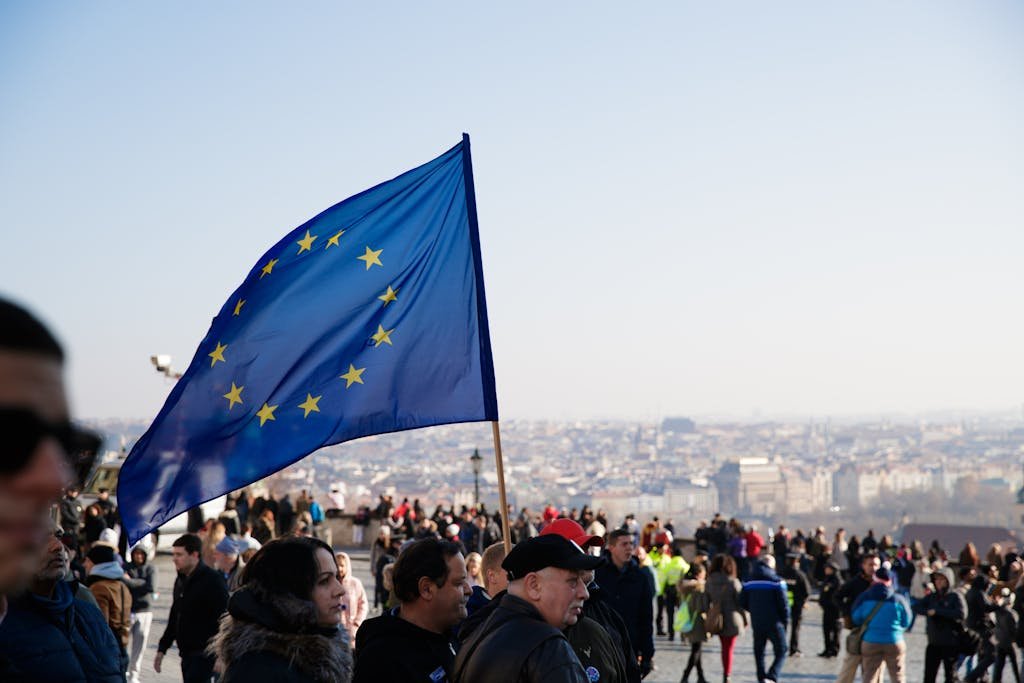EU: Energy and Climate Commitments – laggard or leader?

Clean Energy – Industrial policy
The EU has been accused of being an industrial laggard and its true that its performance has waned behindthe US with per capita GDP only some two thirds that of the US (leaving aside for the moment the question of whether GDP is at all an appropriate measure of success).
Significant in this story has been the US Inflation Reduction Act pumping over $300 billion in tax credits and other incentives towards the transition towards clean energy economy, passed as one of the flag-ship legislative pieces of the Biden administration in 2022. The EU has not been able to match that commitment either in terms of the scope of the incentive or the value, even with its own equivalent scheme, the European Sovereignty Fund, reaching only an additional $10 billion due to the reluctance of member states to commit extra finances.
This is despite the awareness and concern in the EU commission regarding the massive lead that China currently enjoys especially in term of the production of clean technology in critical areas such as silicon based solar panels and lithium based batteries for energy storage and electrical vehicles. This supremacy is telling in terms of the lead that China has taken not only in clean energy capacity and electric vehicles, but also in terms of control and processing of the critical materials.
Clean Energy performance in the EU
However this is not by any means the whole story and it would be misleading to think that the Europe is lacking in either its ambition or its track record to transition to clean energy, far from it. As reported by Energy Monitor, according to the climate consultancy, Ember, clean energy provided Europe overall with 59% of its electricity in the year to February 2024, with Norway, Sweden, Finland and France generating over 90% electricity through non fossil sources, though only in the case of Denmark is this from ‘new clean energy sources’ of wind and solar.
However it is perhaps the rate of change rather than current position that is most notable – in February 2023, fossil fuel based electricity generation contributed 46.5% of European power, by February 2024 that had fallen by over 7% to little over 39%. Comparing the Winter months of January and February in each year there was a 12% increase in clean energy production.
This tells something of the strength of the dynamic behind the transition in Europe, at least for power production. A major challenge will be to maintain and continue to drive that switch as the move to electrification industry and particularly in transport is marked a key element of the transition.
However the move to renewable energy sources is already putting pressure on grid systems throughout Europe with massive amounts of money needed to upgrade the grids, estimated at some $45 billion per year to 2030 . This need for whole system renewal is creating bottlenecks in term of the permitting of new renewable energy as well as push back through the planning system and local opposition to new pylons and powerlines. These bottlenecks which have been described as the ‘overlooked factor in European energy security.
Broader Climate and Nature Policies
But look at what has been achieved against the targets set. The revised EU renewable energy directive raised the renewable energy target to 42.5% by 2030. Considering that almost 60% of energy produced came from renewable energy in February 2024, the targets look like either a bad case of under-ambition or else resounding over-achievement in delivery; probably a mix of both.
Wind actually overtook fossil (natural) gas to produce some 137 terra watt hours of energy! The primary goal however is the reduction of greenhouse gases of 55% by 2030, (raised in the recently adopted Fit for 55 from 40%); and the legally binding target of carbon neutrality by 2050. While the target to 2020 (of 20% reduction) was comfortably achieved, the target for 2030 is more challenging – with estimates on current efforts say they will only reach up to 48% emissions reduction maximum.
Other parts of the Fit for 55 include the expansion of the Emissions Trading Scheme to include road transport and buildings, introduction of a carbon price on imported goods to maintain competitiveness, as well as a zero C02 emissions by 2035 which has proven controversial for EU car makers as for the public.
Public support and shifts to the right
But as we have seen earlier and elsewhere as a major theme and point of concern, the transition isn’t uniformly popular or the reasons either understood, denied or downplayed in what some have considered part of a poisonous cultural wars over a large range of social matters , one that climate change and renewable energy has sadly been drawn into.
There was in fact much concern leading into the European Parliament elections in Summer 2024 that the EU would backslide in its green deal commitments. This has already happened to some extent in the EU’s biodiversity and nature commitments in the face of determined opposition from the agricultural sector.
However this backlash was not evidenced in the GHG ambitions, with the proposal to reduce GHG emissions by 90% by 2040 being proposed by the Commission just before the EU parliamentary elections. How its actual implantation fares both at national and EU levels will be the real test. The overall ‘Green Deal’ package has been particularly criticised by right political groupings as a millstones dragging down national competitiveness and the proposed ban on fossil combustion vehicles as an attach on personal freedoms. Battlelines are being drawn and the role of EU as a climate leader is in the balance.
Resilience on Clean Commitments
Nevertheless, while right wing parties gained ground in the parliament, the gains were not as large as anticipated and Ursula Von der Leyen was comfortably re-elected President of the Commission and broadly pro EU centre right and centre left parties still remain the largest blocks.
But more significantly from a nature and climate perspective, in a major boost to nature preservation, the EU Nature Restoration Law was adopted requiring targeted restoration of degraded lands in each decade up to 2060s. This was adopted shortly after the election in the face of determined opposition from farmers and requiring the Austrian environment minister to support the bill despite the opposition of her government!
Equally controversially on the greenhouse emissions reduction front, the commitment to effectively ban fossil-fuel cars from 2035 remains but with the major watering down hat permits so called ‘e-fuels’ which are meant to be carbon neutral at the insistence of Germany.
Conclusion
So, all in all it is a mixed bag. The EU certainly has challenges in developing its industrial base for producing clean energy raw materials and products and is clearly struggling against the Chinese powerhouse. Nevertheless its climate targets expressed in the Green Deal and in the Fit for 55 are ambitious and aligned to a 1.5% world (in absolute if not in global equitable terms).
However performance delivery is under question with the EU likely to fall short of its 2030 GHG targets. The dilution of ambition is always a risk but, despite gains in the European Parliament by the right, the commitment on key targets in nature and cars remains, for now at least. Public opinion, as seen with farmers protests, will be a major component in the success of measures adopted and delivered over the next 5, 15 and 25 years. The silent majority may support strong climate action but what is needed now is that that majority becomes a little less silent and stands up for clean energy transformation in face of easy but shortsighted objections.
